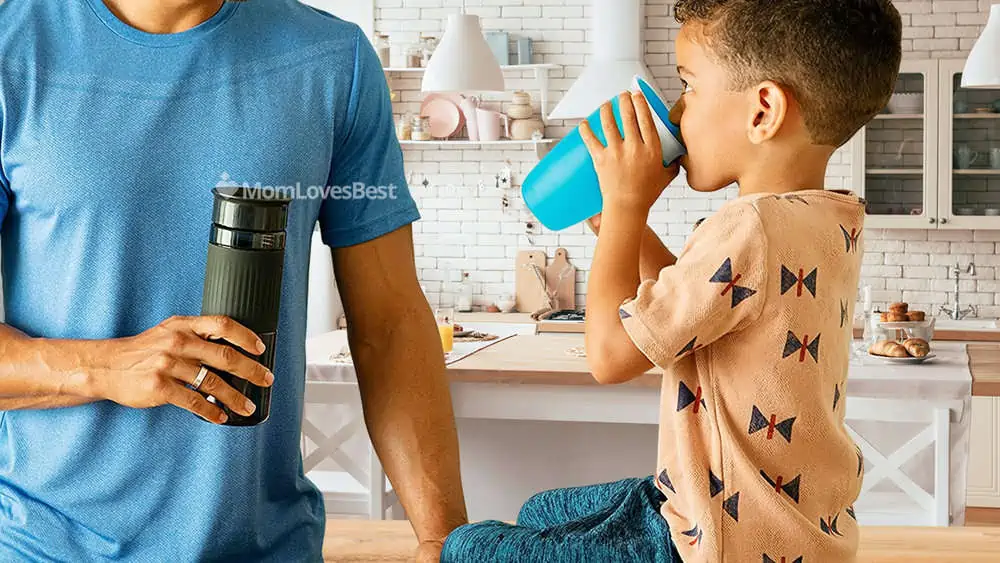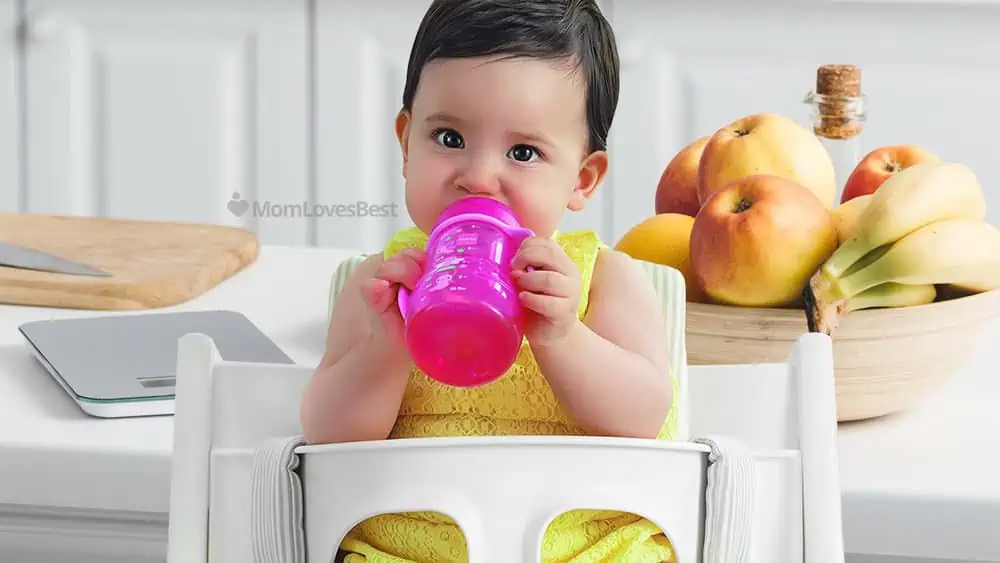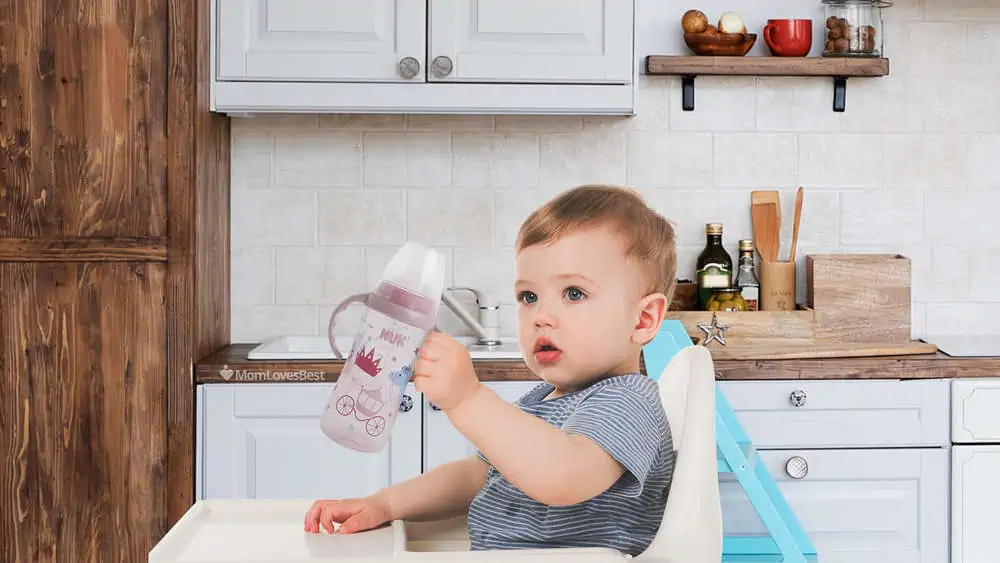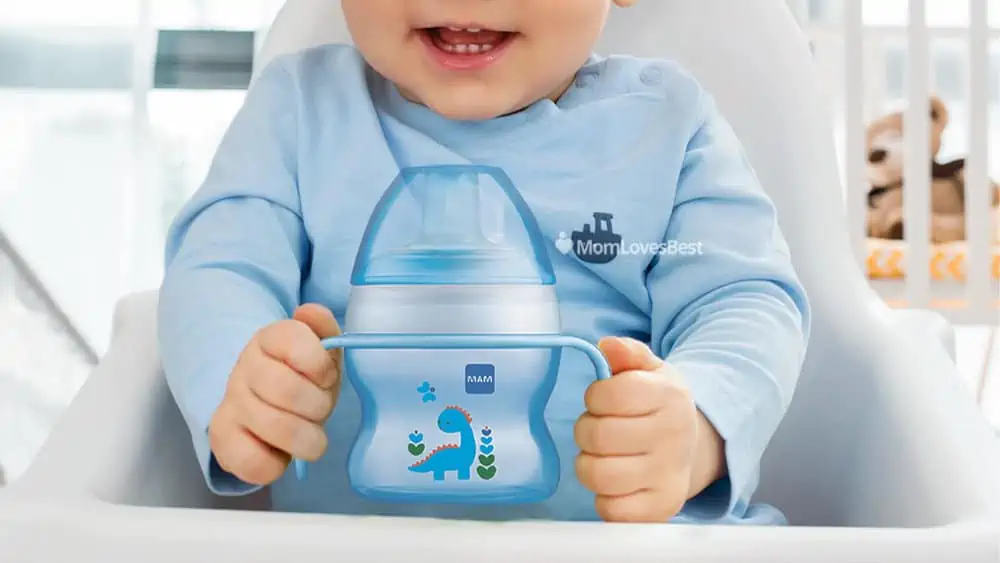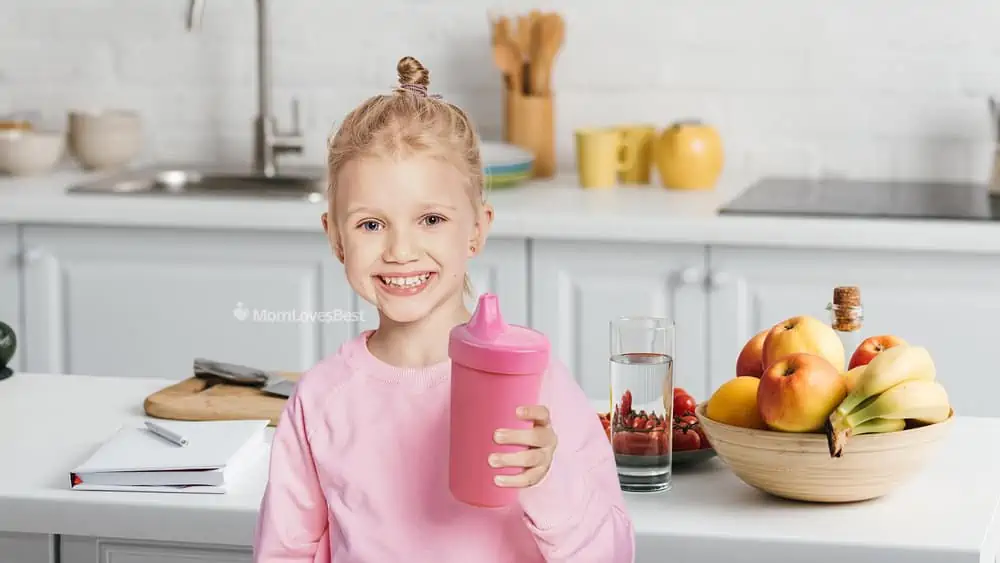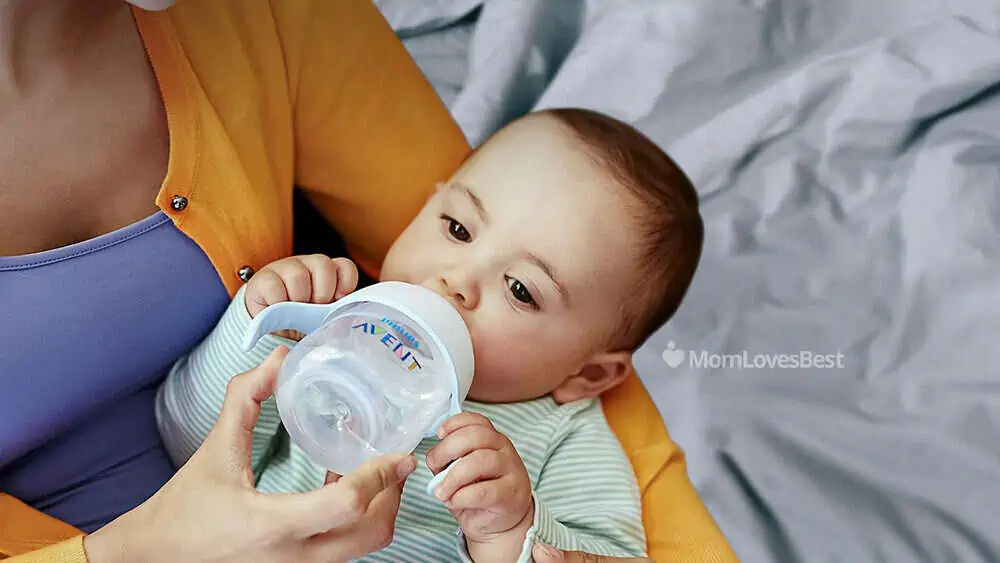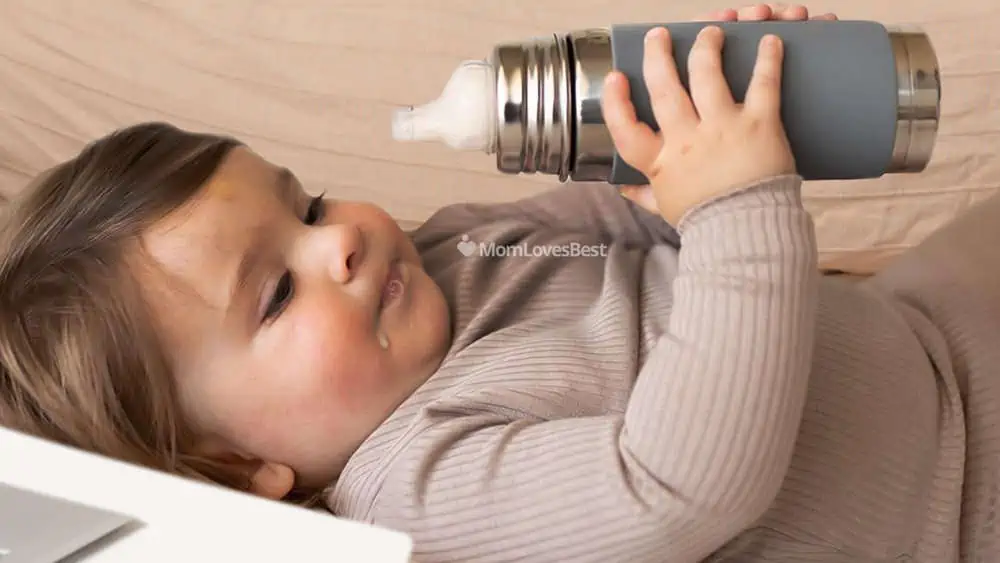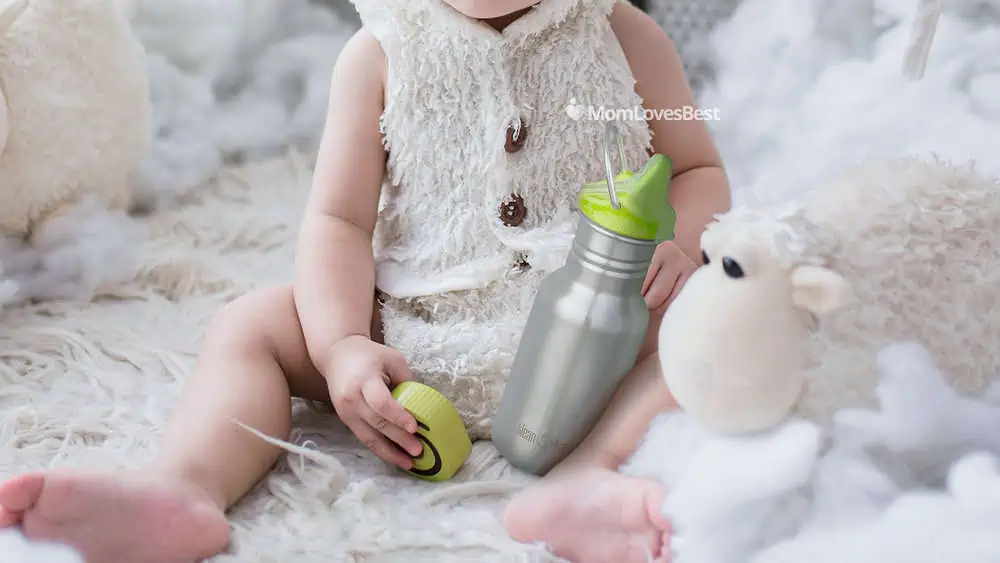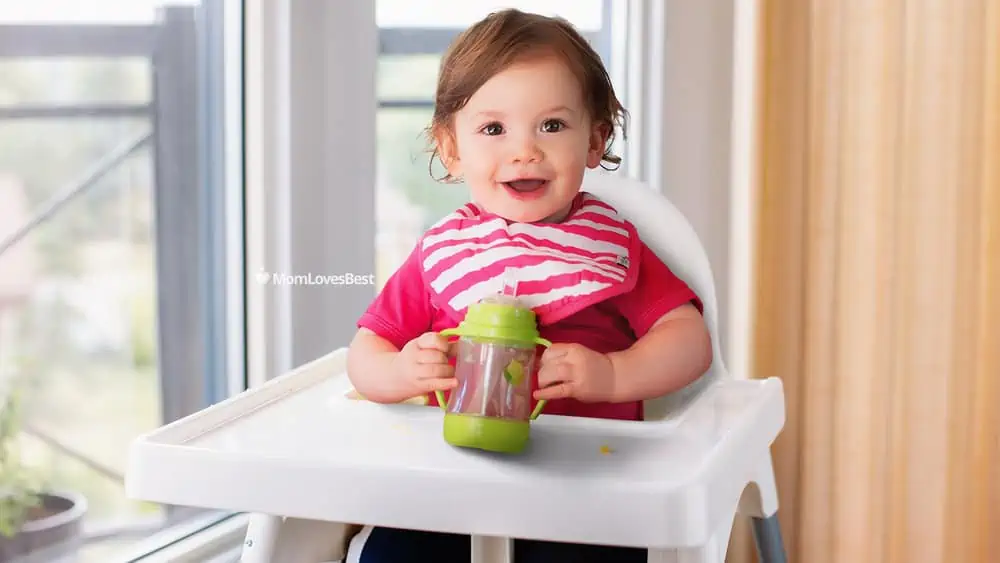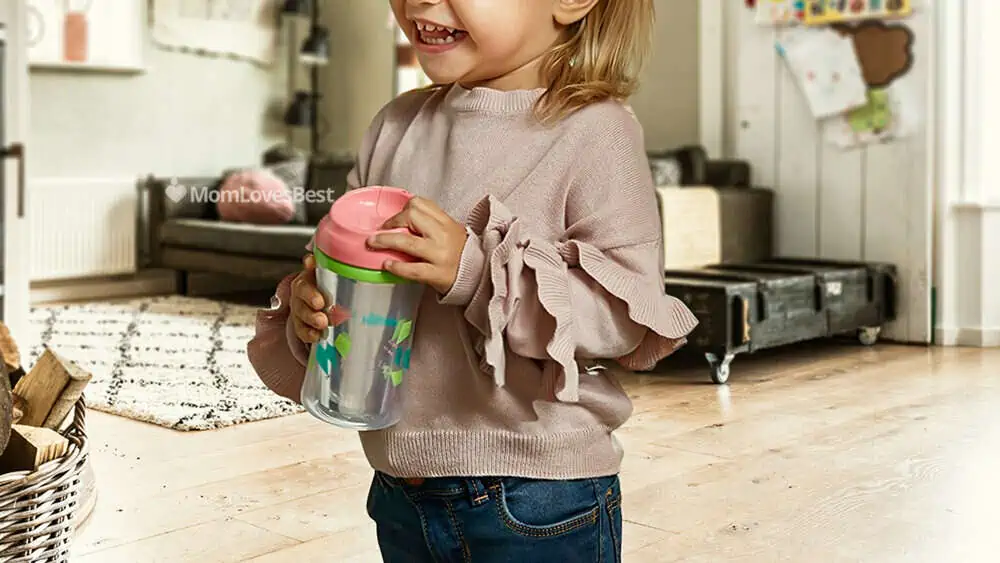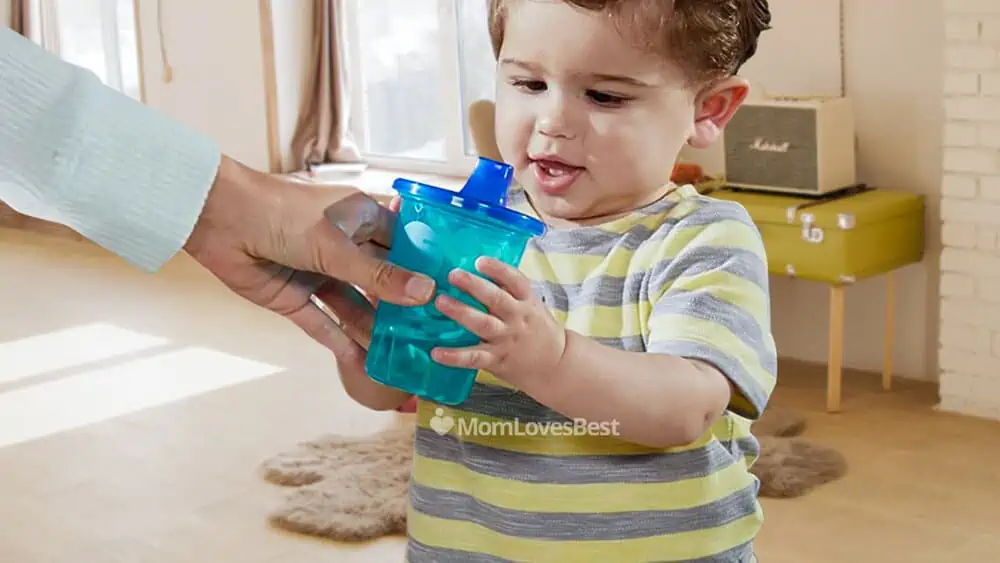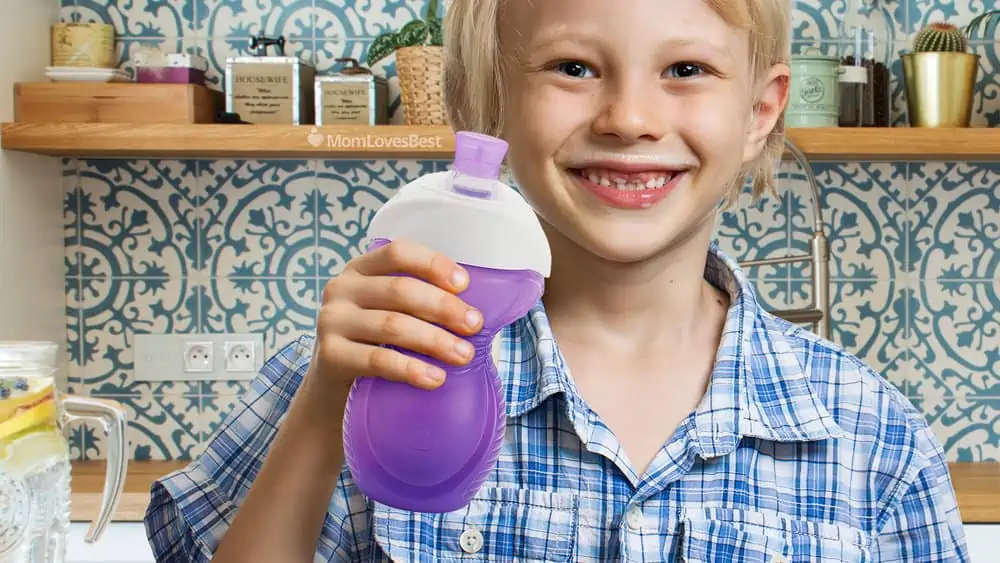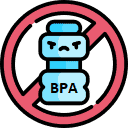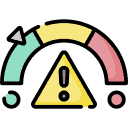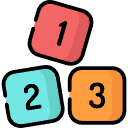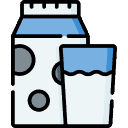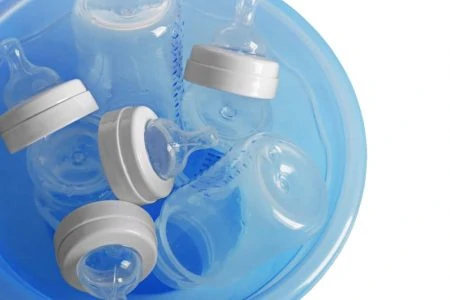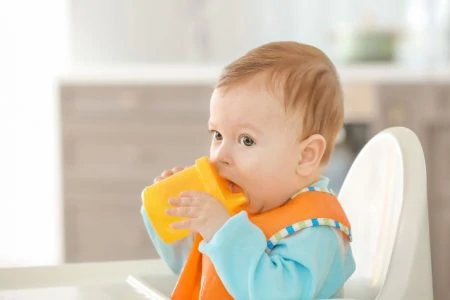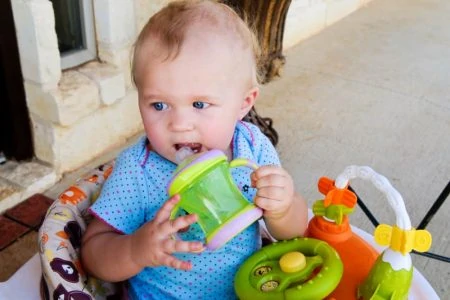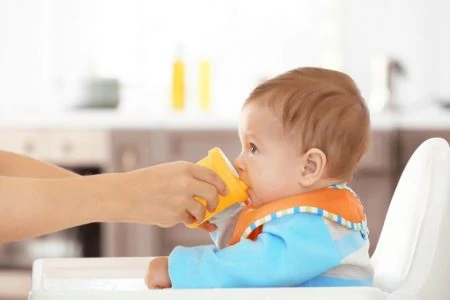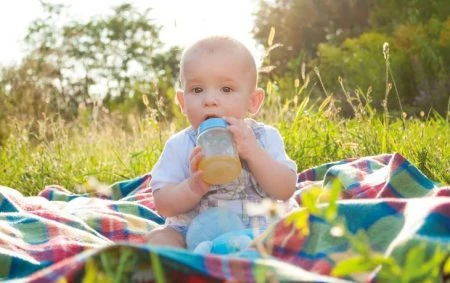Are you overwhelmed with trying to find the best sippy cup for your child? With so many styles available, each looking totally different than the last, it’s enough to drive you crazy.
We’ve spent many hours researching the top-rated sippy cups of all styles and brands. As a result, we’ve created this handy guide with info and reviews to help you find the best sippy cup to suit your child.

- Looks like a standard cup
- Long-lasting
- Spoutless design
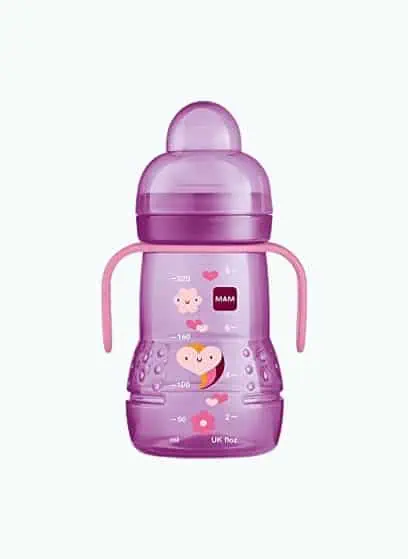
- Includes a nipple & spout
- Protects from spills
- Non-slip handle
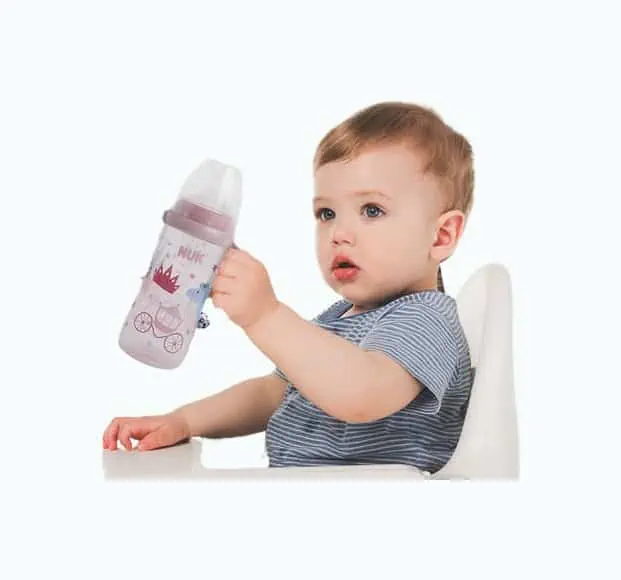
- Built-in air vent
- Gentle on gums
- Easy-grip removable handles

- Lid keeps spout clean
- Ergonomic design
- Durable BPA & BPS free plastic
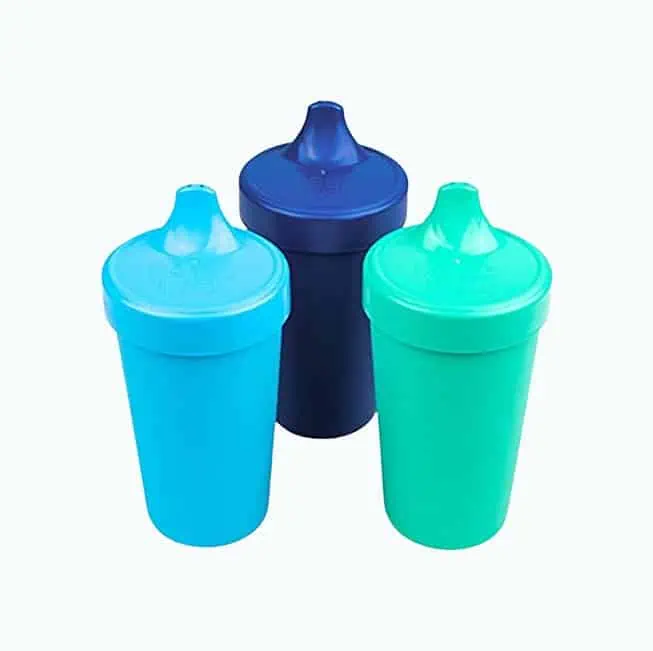
- Won’t leak
- Durable cups
- Fits in car cupholder
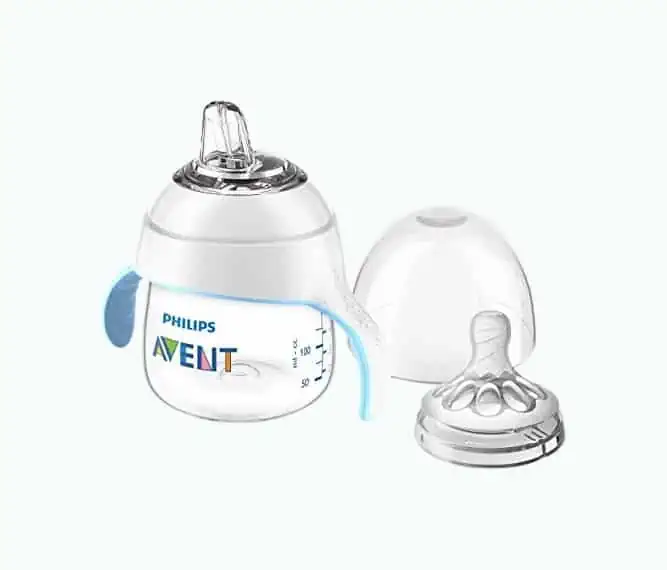
- Affordable
- Rubberized handles
- Soft spout
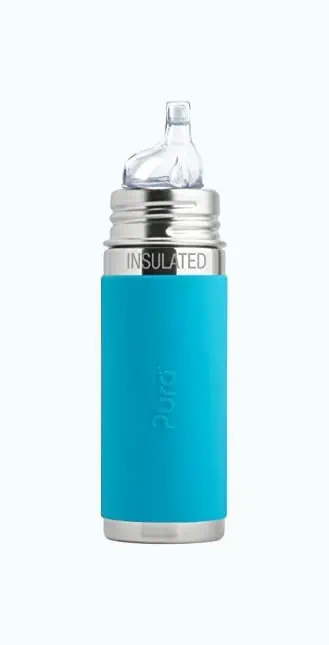
- Includes sipper spout
- Long-lasting bottle
- Interchangeable lids
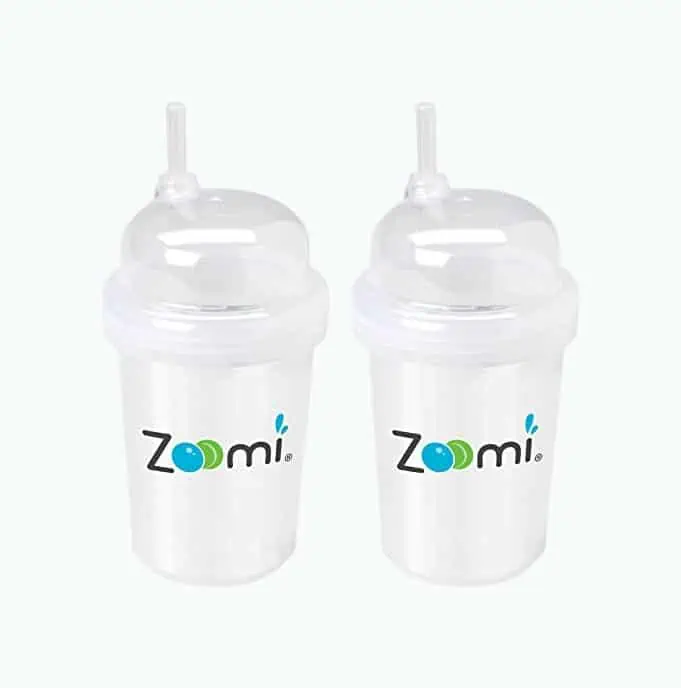
- Gender-neutral cup
- Free from harmful chemicals
- Gentle on baby’s mouth
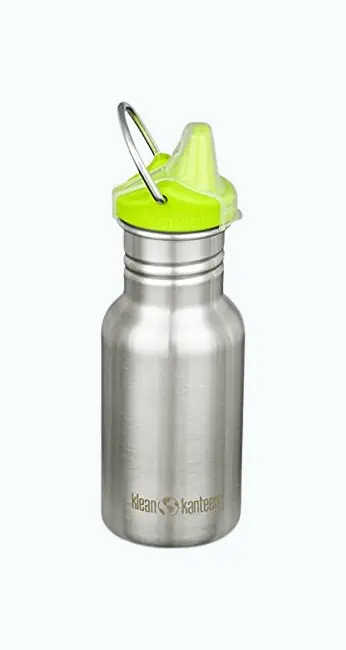
- Different colors to choose from
- Holds 12 ounces
- Food-grade stainless steel
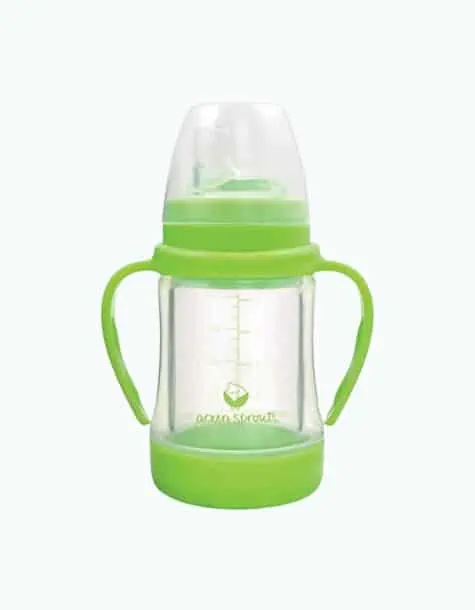
- Includes a spout and straw
- Dishwasher safe
- Shock-absorbing base
Review Methodology: At Mom Loves Best, we understand the importance of finding the perfect sippy cup for your little one. Our thorough analysis and hands-on experience allow us to evaluate products from a user’s perspective, ensuring that we demonstrate our expertise in selecting the best sippy cups. We measure and rank sippy cups based on criteria such as leak-proof design, ease of use, materials, and durability. By comparing qualitative data and first-hand evidence, we identify key decision-making factors and rate the products in those areas. We also assess each cup’s design choices and their effect on users, ensuring that we provide a comprehensive review to help you make an informed decision. Trust in our research, performance assessment, and professional evaluation to guide you in choosing the best sippy cup for your child.
The Best Sippy Cups of 2024
Here are 15 great sippy cups to consider.
Munchkin Miracle 360 Sippy Cup
Best Sippy Cup for Toddlers
It’s hard to get excited about a cup design, but we love the Munchkin Miracle 360 Sippy Cup. Instead of a traditional spout, this cup has a 360-degree drinking edge. Your toddler won’t have to worry about latching onto a mouthpiece to get a sip; they can just pick it up and put it to their mouth without looking.
When your toddler is done taking a drink, the cup automatically seals again.
There aren’t any hard-to-reach valves or pieces, so this cup is easy to clean, either manually or by putting it in the dishwasher. But you need to make sure you fully take apart the four pieces of the cup at each cleaning, or you’ll get a black, yucky-looking ring on the lid.
The Munchkin Miracle 360 Sippy Cup is best for toddlers who are a minimum of 12 months old. The two-pack comes in several bright color combinations.
Pros
- They won’t spill if tipped over.
- Can be used long after the toddler years are over.
- Spoutless design prevents mouth injuries.
Cons
- More expensive than some others.
- You can’t tell how much liquid is still in the cup without taking the lid off.
Our Ratings
User Experience
MAM Trainer Cup with Handles
Best Sippy Cup for a Breastfed Baby
This sippy cup comes with a cap to protect from spills whether you’re at home or in the car. The cap also works as a handy measuring cup.
The non-slip handles help your baby hold on better, and a wide opening and base allow you to fill it easily without spilling.
The best part is that the nipple is soft and spill proof, which means your breastfed baby can take their first step toward using a cup without you having to worry about any mess they make. You also get a spill-proof spout for when your baby is ready to take the next step after training with the nipple.
The base of the cup has measurements clearly marked so you can keep an eye on your child’s intake.
Pros
- You get both a nipple and spout.
- The cap makes this perfect for taking in the car or the diaper bag.
- The handles will help babies hold on.
Cons
- If your baby is a chewer, the spout can be destroyed quickly.
- It takes a lot of suction to get the liquid out.
Our Ratings
Personal Perspective
NUK Learner Sippy Cup
Best Sippy Cup for Gassy Baby
Many bottles are designed to help prevent gas and colic in babies. If too much air gets into your baby’s stomach, it can cause discomfort. However, many sippy cups do not take this into account during the transition process as your baby learns to drink normally.
NUK’s Learner Sippy Cup not only helps your child get excited about drinking from a cup on their own, but it prevents excess air as they move from a sucking action to a drinking action. It works because of a special air vent in the spout. It helps ensure your child swallows liquid, not air.
The spout is also made of 100 percent silicone and is shaped similar to a bottle’s nipple to help with the transition process. Because of the silicone, it is super soft and gentle on your child’s gums, teeth, and palate.
If your child is prone to gas and is at the beginning stages of transition from bottle to cup, this sippy cup is one to consider.
Pros
- Built-in air vent prevents children from swallowing air when drinking.
- Bottle-shaped silicone nipple is gentle on gums.
- Easy-grip removable handles.
- Easy to use.
Cons
- Like with bottles, toddlers get attached and may find it hard to transition to a regular cup.
Our Ratings
Community Feedback
MAM Starter Cup with Handles
Best Spill-Free Sippy Cup
This anti-spill starter cup from MAM holds five ounces of your child’s favorite beverage and features an extra-soft spout. It also has an ergonomic design, with a curved bottle and non-slip handles, so your child can hold and carry it with confidence.
Best of all, the soft spout is completely spill-free. Not only does this make your life easier, but it helps your little one transition from sucking to drinking. A dust cap is also provided to prevent spills during transport and protect from dirt and germs.
The entire sippy cup is made of durable plastic, which is BPA and BPS free. We love it for on-the-go moms who don’t have time to worry about cleaning up spills.
Pros
- Anti-spill spout and lid prevent stressful messes.
- Ergonomic design helps your child learn to drink from a cup with confidence
Cons
- Soft nipple is easy for biters to damage.
Our Ratings
First-Hand Impression
Re-Play Sippy Cups
Best Sippy Cup for Milk
Your child will be able to get milk out of these Re-Play cups at a fairly fast rate — even faster without the silicone valve.
They hold 10 ounces of liquid and can be used for milk, juice, or water. Since they have a hard spout, they’re best for babies that are nine months and older.
They use a one-piece spill-proof valve, which means they’re easy to clean, and you won’t find yourself crying over spilled milk. As long as you put the valve in properly, these cups won’t leak. As your toddler gets older and spills less, you can remove the valve.
You’ll get a three-pack of cups in different colors. They are free of BPA, Phthalate, PVC, and Melamine and are made from recycled milk jugs. They are top-rack dishwasher safe. It’s easy to take them apart and put them back together again — you’ll even be able to do it while you have a thirsty, demanding kid on your hands.
Pros
- Leak-free design.
- Durable cups hold up well to the abuse children can deliver.
- Narrow design is cupholder friendly.
Cons
- They don’t come with lids.
Our Ratings
User Experience
Philips Avent My Natural Trainer Cup
Best Transition Sippy Cup
This sippy cup by Philips Avent is made for babies from four months up. It has a soft silicone spout, so it won’t feel much different from the bottle for them.
Made of BPA-free plastic, these cups can be put in the dishwasher for cleaning. Their best feature is that they are compatible with other Philips Avent bottle and cup pieces. That gives them greater versatility because if you have a piece from your bottle that your baby loves, you can make it work with these cups.
This sippy cup comes with a cap, making it easy to keep clean. Finally, it has trainer handles, allowing babies to get a good grip until they fine-tune their motor skills.
Pros
- Cheaper than other similar options.
- Rubberized handles are comfortable for babies.
- Compatible with other Philip Avent cups and bottles.
Cons
- Wider design won’t fit in cupholders.
- Top is easy to unscrew, so a busy baby can get it off and make a mess.
Our Ratings
Personal Perspective
Pura Kiki Stainless Steel Insulated Sippy Cup
Best Stainless Steel Sippy Cup
This cup doesn’t use any plastic, and it can grow with your child. Your child will be able to use the same bottle year after year simply by switching out the lids as they graduate from each stage of drinking.
The bottle comes with a sipper spout, but you can purchase other lids separately, such as a straw and a cap. It holds nine ounces of liquid, so it’ll always be useful, no matter your child’s age.
The cup base is made from food-grade stainless steel and the spout from medical-grade silicone. So you don’t have to worry about BPA, BPS, EA, PVC, or any other chemicals making their way into your baby’s drink.
A variety of bright silicone sleeves make this cup stand out and allow for a better grip.
Pros
- Entirely plastic free.
- Made to last years with combination of bottle and sippy tops.
- Bright silicone sleeve reduces the chances of it dropping.
Cons
- These cups are expensive.
- Can damage a furniture when thrown by a child having temper tantrums as it is on a heavier side.
Our Ratings
Community Feedback
NuSpin Kids Zoomi Straw Sippy Cup
Best Straw Sippy Cup
This sippy cup has a valve-free straw and is made without BPA, phthalates, PVC, nitrosamines, latex, and lead. It consists of only three pieces — the base, a lid, and straw — and all are safe to put in the top rack of the dishwasher.
This is best for kids who are at least one year old, and you can use it with milk, juice, or water.
The soft silicone straw cannot be pulled from the cup as long as the lid is on.
Pros
- Nice-looking neutral-colored cup.
- Uses a durable silicone straw.
- Soft straw won’t hurt the inside of a baby’s mouth.
Cons
- For a single cup, the cost is a bit high.
- They don’t come with lids, so they aren’t great for travel.
Our Ratings
First-Hand Impression
Klean Kanteen Sippy Cup
Best Toddler Cup
This cup isn’t tainted by the harmful chemicals and compounds you’re trying to avoid. It’s made of food-grade stainless steel that doesn’t contain BPA or any other plastic byproducts you’re worried about.
It will never give your child’s drink that awful plastic taste, and the stainless steel won’t smell like the last drink you had in the cup.
The valve is removable for easy cleaning in the dishwasher or by hand. The opening is large enough that you can add ice cubes to your child’s drink if you want to, but still thin enough to fit in most car cup holders.
While it isn’t as lightweight as some of the flimsy plastic cups you can buy, it isn’t too heavy for your child to lift comfortably either.
Pros
- It comes in several different colors.
- Holds twelve ounces of liquid.
- Durable design holds up to rough usage.
Cons
- Hand washing is recommended for colored cups.
- More expensive than plastic cups.
Our Ratings
User Experience
Green Sprouts Glass Sip and Straw Cup
Best Glass Sippy Cup
The four-once sippy cup is made of glass but includes a soft plastic outer base to absorb shocks and prevent breakage if dropped. The soft silicone nipple has a free-flow design, making it a great transition cup for breastfed babies.
With the option of a straw or sippy spout, your baby can drink in the way most natural to them.
Although parts of the exterior are made of polypropylene and synthetic rubber, the liquid only touches glass and silicone.
This cup is free of BPA and PVC and is easy to clean, dishwasher safe, and suitable for babies as young as four months. The removable handles are a bonus in case your baby does better without them.
Pros
- It comes with both a spout and a straw.
- It can be cleaned in the dishwasher.
- Babies can use it from a young age.
Cons
- More expensive than many other sippy cups.
- Glass may fracture or break with rough handling.
Our Ratings
Personal Perspective
NUK Silicone Spout Active Cup
Best Silicone Sippy Cup
If you love the soft feel of a silicone spout, this cup is a great choice.
It’s great for kids who are trying to wean off the bottle because of the soft spout and bottle-like shape of the cup. The spout is gentle on teeth and gums as babies learn to handle the next milestone.
Kids will love the cheerful design, and moms will like that it’s leakproof.
It’s light enough that even young babies will have no trouble picking it up. Plus, it holds ten ounces of liquid, making it big enough for kids to continue using as they become capable of drinking more liquids.
Pros
- It’s an affordable cup.
- Includes a clip so you can attach it to a diaper bag or purse.
Cons
- If you have a fierce biter on your hands, they may destroy the spout.
- Your child will have to suck hard to get liquid from this.
Our Ratings
Community Feedback
Gerber Advance Developmental Insulated Cup
Best Orthodontic Sippy Cup
This cup is easy on a baby’s developing teeth because it has a flat rim, much like an adult cup would. If you have a little one who likes to bite everything, you’ll appreciate the bite-resistant rim.
The design still allows it to be completely leakproof. Plus, it’s so durable that your child won’t be able to break it, even when dropping it from a high chair.
These dishwasher-safe cups come in a package of two. They’re BPA free, which brings peace of mind to moms who are worried about chemicals entering their baby’s drink.
The insulated design keeps drinks cool for up to six hours.
Pros
- The flat rim will help your child transition to regular cups.
- Keeps drinks cold for hours.
- Babies love the eye-catching designs.
Cons
- Lids crack easily.
- Moisture might get trapped between the insulating layers.
Our Ratings
First-Hand Impression
The First Years Spill-proof Sippy Cup
Best Budget Sippy Cup
This four-pack of brightly colored cups from The First Years is durable enough to get a few months of use but cheap enough to be used as a disposable cup.
This is the perfect solution if you’re constantly losing sippy cups since it’s so affordable to replace them. The snap-on lids are interchangeable, each coming with an attached cap that prevents leaks and keeps the mouthpiece clean.
The transparent design allows you to see how much liquid is left, and when they’re dirty, they can go straight into the dishwasher. These cheerful cups don’t contain PVC, BPA, or phthalates.
Pros
- Only two pieces to clean.
- Can be used as regular cups by removing the lids.
- Stackable design saves storage space.
Cons
- The lids come off easily and may cause leaks.
- The plastic is not durable and will mark and fade with time.
Our Ratings
User Experience
Munchkin Click Lock Sippy Cup
Best Insulated Sippy Cup
This package of two cups can be used by children who are nine months and older. These cups have a click-lock leakproof design and a one-piece valve that won’t spill if the cup gets tipped over. You’ll hear a click when you correctly screw the lid on the base, so it takes the guesswork out of whether you have everything lined up correctly.
Because the cups are insulated, they keep drinks cool longer than non-insulated cups will. They’re top-rack dishwasher safe and fit into most cup holders, which is nice if your child likes to have water to drink in the car.
Finally, the hard, bite-proof spout is nice for those kids who love to chew.
Pros
- They’re super affordable.
- Top-rack dishwasher safe.
- Durable bite-proof spout.
Cons
- Hard to find replacement spouts.
- Tougher silicone spout requires pressure to drink from.
Our Ratings
Personal Perspective
Gerber Hard Spout Sippy Cup
Best Hard Spout Sippy Cup
This two-pack has cups with a hard spout for parents who like the look of traditional sippy cups. The spouts are bite resistant, which may be comforting for parents whose children bite everything when they are teething.
They’re made in the U.S., are BPA-free, and are guaranteed to be leakproof. This cup holds ten ounces of liquid and is ideal for kids who are at least 12 months old.
These are simple to clean — all you have to do is pop out the valve and put it back in the lid after you’ve cleaned it.
The heavy-duty design doesn’t rub off even after repeated use and washings.
Pros
- Lids are easy to screw on.
- They’re affordable.
- Durable cups won’t break even when forcibly dropped.
Cons
- Require strong suction to work.
- Valve gets moldy if not thoroughly cleaned after every use.
Our Ratings
Community Feedback
When Should a Baby use a Sippy Cup?
Sippy cups are used to transition your baby from the breast or bottle to a real cup. Toddlers don’t quite have the balance and stability to carry around a regular cup. That’s where sippy cups come in handy. They cut down on spills — and your frustration levels.
Ideally, your child won’t be using bottles past their first birthday for a few reasons. It helps protect their developing teeth (1). And if you wait too long, your child will get too attached to their bottles, and you’ll have to struggle to wean them off of them.
But if your baby can’t do it by the time they turn one, you should aim to have them completely weaned from their bottles by 18 months of age.
To get your baby used to the sippy cup, you should begin to introduce it months before. Some babies are ready to be introduced to sippy cups as early as six months old. If your child isn’t ready then, you should aim to try by nine months at the latest to allow them time to become comfortable with it by their first birthday.
Types of Sippy Cups
All sippy cups have a similar structure, but designs tend to look different. These are the pieces that make up most sippy cups.
- Spout: This is the place where a child suckles to get liquid from the cup. It functions like the nipple of a bottle and is usually part of the lid.
- Lid: This is the top of the sippy cup.
- Valve: Sippy cups have a valve to prevent leakage when the child is not sucking. This is usually a removable plastic piece inside the lid, though some are built directly into the spout.
- Cup: This is the main part of the sippy cup — the reservoir where the liquid is held.
- Handles: Some brands have handles, and others don’t. Whether or not you use a cup with handles is a personal preference. Some handles are removable, while others are built into the cup or lid.
Silicone Spout Cups
These are wide, sippy-shaped spouts made out of the same material as a bottle nipple. They are flexible and feel familiar to the bottle-fed baby.
Pros
- Good for bottle-fed babies.
- Babies are reluctant to give up the bottle like the similar feel of the soft spout.
Cons
- Not great for older toddlers.
- Babies with teeth tend to chew on the spout.
Soft Spout Cups
These are sippy cups with a soft plastic spout. The spout is not fully flexible and pliable but has some give to it.
Pros
- Great for first-time sippy users.
- Good for younger babies.
- Gentler on baby teeth.
Cons
- Not great for toddlers and preschoolers.
- Babies like to chew the spout.
Hard Spout Cups
These look similar to soft spout sippy cups, but the spout is made of harder plastic.
Pros
- Suitable for toddlers and preschoolers.
- Harder for little teeth to destroy.
Cons
- Not for younger babies.
- Not an introductory sippy cup.
Spoutless Cups
Kids can drink from these no-spill sippy cups by sucking on any point around the rim. They help develop the skills and muscle control to drink out of a regular cup. They can be used at any age.
Pros
- Makes transitioning from bottle to cup easier.
No risk of teeth malformation.
Cons
- Not easy for a young baby to use.
Straw Cups
Instead of a spout, these cups come with a silicone straw. Their valve makes them spill-proof, separating them from non-sippy-style straw cups.
Pros
- For babies or toddlers who like to suckle (particularly breastfed babies).
- For babies or toddlers who have refused regular sippy cups.
Cons
- Some kids struggle with remembering not to tip the cup upward.
- Not typically an introductory cup.
How to Choose Sippy Cups
Picking out a sippy cup can be difficult, but it’s easier if you know what you’re looking for. I found that out the hard way when I grabbed a pack in the store one day without putting any thought into it at all. I just went for the cheapest ones.
That bargain wasn’t such a bargain after all. My daughter had destroyed the cheap spouts by the end of the first week by biting on them furiously. I had to replace the whole pack, but obviously, I didn’t get the same kind again.
I put more thought into it and asked a friend what kind her child had been using. She led me to one she loved and, although it was pricier than what I’d bought, they were well worth the money because they held up until my baby was ready to transition from bottle to cup.
Keep these features in mind when looking for a cup your baby will love:

